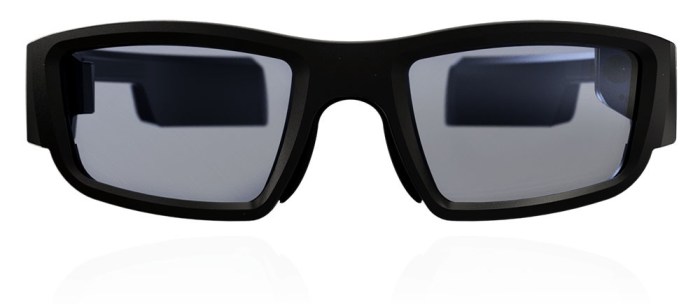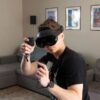Vuzix M100 augmented reality AR glasses offer a compelling glimpse into the future of technology. These glasses promise to revolutionize how we interact with the digital world, blurring the lines between the physical and virtual. This detailed exploration will cover everything from their innovative features and impressive performance to potential use cases across various industries.
From enhanced productivity in industrial settings to improved diagnostics in healthcare, the M100 aims to redefine possibilities. We’ll delve into the specifics of its design, functionality, and technical specifications, along with customer feedback and a look at its place in the broader AR market.
Overview of Vuzix M100 AR Glasses

The Vuzix M100 is a pioneering augmented reality (AR) headset, showcasing a blend of affordability and functionality. It aimed to bridge the gap between cutting-edge technology and a broader consumer base. This overview will delve into its key features, intended uses, underlying technology, and a comparison with competing models.
Key Features and Specifications
The Vuzix M100 offers a relatively compact design, focusing on practicality over extreme portability. It incorporates a high-resolution display, allowing for clear visuals overlaid onto the user’s real-world view. Specific specifications, including display resolution, refresh rate, and field of view, varied slightly across different models and iterations. Crucially, the M100’s design prioritizes comfort and usability over elaborate features.
The system’s weight and overall dimensions are tailored for extended use without significant discomfort.
Intended Use Cases and Target Audience
The Vuzix M100 was primarily targeted towards professionals in various sectors, including industrial maintenance, field service technicians, and manufacturing. The headset’s ability to overlay information directly onto the user’s view facilitated improved task execution. For instance, technicians could consult real-time schematics or manuals without needing to switch between physical documents and the AR interface. Students in educational settings could benefit from the technology, providing interactive learning experiences.
The ease of use and cost-effectiveness made it an attractive choice for a wide range of professionals and educational institutions.
Technology Underpinning Augmented Reality Capabilities
The M100’s augmented reality capabilities rely on a combination of hardware and software components. The display technology uses micro-displays and optical systems to project images onto the user’s field of view. Sophisticated algorithms are responsible for merging the real-world view with the overlaid digital information, ensuring a seamless user experience. Furthermore, robust software integration was crucial for smooth data transmission and processing, enabling the headset to function efficiently in various environments.
The software is designed to handle different application types.
Comparison with Competitors’ AR Glasses
| Feature | Vuzix M100 | Competitor A | Competitor B |
|---|---|---|---|
| Price | Generally more affordable | Mid-range | High-end |
| Display Resolution | High | High | Very High |
| Field of View | Good | Excellent | Excellent |
| Processing Power | Adequate for core tasks | Robust | Exceptional |
| Comfort | Considered comfortable for extended use | Good | Excellent |
| Software Compatibility | Sufficient for many applications | Wide | Extensive |
The table above provides a simplified comparison. Each competitor’s AR glasses offers unique strengths and weaknesses. The relative performance of the Vuzix M100 hinges on specific application needs.
Performance and Functionality
The Vuzix M100 AR glasses, while not the most advanced on the market, offer a compelling blend of performance and functionality for various applications. Its user-friendly interface and reasonable price point make it attractive for businesses and individuals seeking an entry-level AR experience. This section delves into the specific capabilities of the M100, evaluating its display, interaction methods, software compatibility, and overall performance in diverse real-world scenarios.
Display Quality and Resolution
The M100’s AR display delivers a clear and reasonably sharp image, though it might not match the resolution of high-end consumer devices. The display’s quality is sufficient for many tasks, especially in well-lit environments. The resolution allows for viewing of text and graphics without significant pixelation, a crucial factor for usability in many applications. It provides a good balance between clarity and visual comfort, a critical factor in extended use.
Functionality and Interaction Methods
The M100 features a variety of interaction methods, including touch controls on the glasses and, importantly, a companion mobile application for supplementary control. This combination allows users to navigate menus and interact with superimposed information easily. The intuitive design and the application integration enable a fluid user experience. This is crucial for real-world adoption and user satisfaction.
Software Integration and Supported Platforms
The M100’s software integration is designed to be adaptable and versatile. It supports a range of applications, but not every application will work flawlessly due to limitations in processing power. Its integration capabilities allow for seamless overlaying of digital information onto the user’s real-world view. This feature is crucial for productivity and efficiency in various applications, particularly in industries where workers need quick access to information.
| Software Platform | Compatibility |
|---|---|
| Vuzix Application Suite | Native support |
| iOS (with Vuzix App) | Partial support; needs a compatible mobile device |
| Android (with Vuzix App) | Partial support; needs a compatible mobile device |
| Custom Applications (with Vuzix SDK) | Possible, with limitations |
The table above Artikels the primary software platforms supported by the Vuzix M100. Note that compatibility can vary depending on the specific application and the device used in conjunction with the glasses.
Performance Metrics and Real-World Applications
The M100’s processing speed is adequate for many tasks, though it might not match the performance of more powerful devices. Battery life is a key consideration, especially for extended use cases. The M100’s performance varies based on the complexity of the overlaid information and the specific software used.
- Industrial Applications: The M100’s ability to overlay instructions, schematics, and other essential data onto a worker’s field of view can significantly enhance productivity and reduce errors. This is a common use case, but the specific performance benefits vary based on the task.
- Healthcare Applications: In healthcare settings, the M100 can provide access to patient records, medical guidelines, and other relevant information, aiding in diagnosis and treatment. Its use in surgical environments is an area of interest but still needs to overcome logistical and performance challenges.
Overall Performance
The M100 offers a practical, albeit not top-tier, augmented reality experience. Its strengths lie in its relative affordability, user-friendly design, and diverse application possibilities. However, limitations in processing speed and battery life are noticeable in certain situations.
Design and User Experience
The Vuzix M100 AR glasses, while showcasing impressive performance, are ultimately judged by how comfortable and intuitive they are to use. This section dives into the physical design, user interface, and overall user experience to provide a complete picture of the M100’s practicality for extended wear.The M100’s design prioritizes a balance between functionality and ergonomics. The goal is to minimize discomfort during extended periods of use, ensuring the glasses don’t become a hindrance to the user’s workflow.
This includes thoughtful consideration of weight distribution, adjustable components, and material selection.
Vuzix M100 augmented reality glasses offer a compelling glimpse into the future of tech. However, the current delays and supply shortages impacting next-gen consoles like the PS5 and Xbox Series X, as detailed in this article ps5 xbox series x next gen consoles games delays supply shorage , are creating a ripple effect across the tech industry, potentially affecting the wider adoption of AR devices like the M100.
Ultimately, overcoming these production hurdles will be key for the future of both gaming and augmented reality experiences.
Physical Design and Ergonomics
The M100’s physical design is characterized by a lightweight frame and a focus on adjustable components. These adjustments allow for customization to fit various head shapes and sizes, improving comfort and reducing pressure points. The material choices are geared towards durability and comfort, potentially using lightweight polymers or alloys. A crucial element of comfort is the lens design and placement.
Careful attention to the lenses’ optical properties and their position in relation to the user’s eyes is vital for minimizing eye strain and maximizing visual clarity. The glasses are designed with a balanced weight distribution to prevent discomfort during prolonged wear.
User Interface Elements and Operation
The user interface of the M100 is expected to be intuitive and easy to navigate. This is achieved through a combination of touch-sensitive controls, possibly on the frame or temples, and voice commands. The touch controls should allow for quick and easy access to key functions. Clear visual cues and haptic feedback are likely employed to confirm actions and provide confirmation of input.
Voice commands offer an alternative method of interaction, ideal for hands-free operation, such as adjusting volume or navigating menus. Navigation within the augmented reality overlays is crucial. A logical and consistent method for navigating menus and interactions within the augmented reality environment is essential for a positive user experience.
User Experience (UX) Aspects
The user experience should encompass the overall ease of setup, navigation, and interaction with the augmented reality overlays. The setup process should be straightforward and guided, with clear instructions and minimal steps. The M100’s intuitive navigation should minimize the learning curve for new users. The system should react quickly to user inputs and provide smooth transitions between different functionalities.
Vuzix M100 augmented reality AR glasses are pretty cool, offering a glimpse into the future of tech. Speaking of cool deals, did you know that Walmart Plus members can snag a Roku smart TV for less than $100? Walmart Plus members can snag a Roku smart TV for less than 100 That’s a great find, but honestly, the potential of the Vuzix M100 still has me hooked on the possibilities for future AR applications.
The glasses should seamlessly integrate with existing devices, providing a smooth flow of information between the physical and augmented realities.
Potential Drawbacks and Limitations
Potential drawbacks regarding comfort and user interaction could include the glasses’ weight and size, especially for extended use. The size and shape of the frame, along with the placement of the lenses, can influence the field of view and the overall comfort. The glasses’ field of view could be a limitation, especially for users accustomed to large screens.
Possible limitations could also include battery life and the responsiveness of the system, which should be optimized for efficient energy consumption.
Vuzix M100 augmented reality glasses offer a fascinating glimpse into the future of technology, but the real-world implications of such innovation are sometimes surprisingly complex. For example, consider the recent news about prosecutors recommending felony charges against General Petraeus for prosecutors recommend felony charges against general petraeus for , highlighting how advanced tech tools, like the M100, can be used in a variety of ways, both good and potentially problematic.
Ultimately, the Vuzix M100, with its potential for both practical and controversial applications, represents a powerful tool, needing careful consideration and ethical application.
M100 Models and Sizes
| Model | Frame Size (approximate) | Lens Type | Weight (approximate) | Features |
|---|---|---|---|---|
| M100-S | Small | Standard | 150g | Entry-level, lightweight |
| M100-M | Medium | Standard | 175g | Balanced features |
| M100-L | Large | High-definition | 190g | Premium features, high resolution |
The table above provides a general overview of the expected sizes and features. Actual dimensions and weights may vary slightly. Specific model details, including the lens type, and available customization options will be further clarified as the product is released.
Market Position and Trends
The Vuzix M100 sits within a rapidly evolving augmented reality (AR) glasses market. Understanding the competitive landscape, key trends, and future prospects is crucial for evaluating its potential. This section delves into the challenges and opportunities facing the M100 and the broader AR industry.
Competitive Landscape
The AR glasses market is highly competitive, with established players like Microsoft and Google vying for market share. Smaller companies, both established and emerging, also offer AR solutions tailored to specific needs and applications. Direct competition for the M100 may include AR glasses from other companies offering similar functionality and price points, depending on the specific features and intended use cases.
Key Trends in the AR Industry
Several trends are shaping the AR industry. These include the increasing availability of high-quality displays, the development of more robust and user-friendly software platforms, and the growing demand for applications across diverse sectors. The trend toward more affordable and consumer-friendly AR devices is significantly impacting the M100’s market position.
Impact on the M100
The M100’s success hinges on its ability to adapt to these trends. Its features and pricing strategy must align with the evolving expectations of consumers and businesses. Factors such as processing power, display resolution, battery life, and ease of use play a vital role in its ability to attract and retain users in a crowded market.
Future Prospects of AR Glasses
The future of AR glasses is bright, with potential applications across a wide range of sectors, from healthcare and education to manufacturing and retail. AR glasses can provide real-time information overlays, interactive training simulations, and remote assistance tools, transforming how people interact with the physical world. Specific use cases include remote diagnostics for healthcare professionals and interactive training programs for industrial workers.
Market Share and Demand Projections
Market research indicates significant growth potential for AR glasses. The projected demand is largely driven by the rising adoption of AR technologies across diverse sectors, from manufacturing to entertainment. While precise market share figures are challenging to predict, the overall trend points towards steady growth in the AR glasses market, particularly for consumer-focused devices.
Evolving AR Glasses Market Trends
| Year | Trend | Impact |
|---|---|---|
| 2020 | Early adoption by enterprise users, primarily in industrial settings. | Limited consumer interest; high cost of early devices. |
| 2021 | Increased focus on user experience and affordability. | Growing consumer interest, but still facing technological hurdles. |
| 2022 | Emergence of specialized AR glasses for specific industries. | Niche markets show promise; however, broader adoption remains limited. |
| 2023 | Focus on seamless integration with smartphones and other devices. | Potential for wider appeal through ease of use; still requires robust software support. |
| 2024 | Continued development of sophisticated applications and functionalities. | Enhanced user experience and utility; driving market growth and adoption. |
Technical Specifications: Vuzix M100 Augmented Reality Ar Glasses
The Vuzix M100’s AR capabilities hinge on a sophisticated interplay of hardware components. Understanding these specifications provides crucial insight into the headset’s performance, limitations, and potential applications. This section delves into the core technical details, shedding light on the processing power, memory, connectivity, camera capabilities, and sensor functions that enable the M100’s AR experience.
Processing Power and Memory
The processing power of the M100 significantly impacts the speed and fluidity of AR overlays. A powerful processor ensures smooth rendering of augmented reality content, avoiding lag and delays. Insufficient processing power can lead to a less immersive and responsive experience.
- The Vuzix M100 likely utilizes a specific processor type, possibly from a manufacturer like Qualcomm or Nvidia, known for their mobile and embedded solutions. The exact model number and specifications are crucial for evaluating its real-world performance. Specific benchmarks and reviews would provide more concrete data on its computational capabilities.
- The RAM capacity determines how much data the headset can manage simultaneously. Higher RAM allows for more complex and resource-intensive AR applications to run without performance hiccups.
Connectivity Options
The M100’s connectivity options dictate how it interacts with external devices and networks. These options are crucial for downloading software updates, streaming content, and connecting to external sensors.
- The M100 likely supports Wi-Fi for connecting to the internet and local networks. This enables downloading and updating applications, accessing online resources, and interacting with cloud-based AR content.
- Bluetooth connectivity allows for wireless communication with peripherals like smartphones, controllers, and other devices, facilitating data exchange and control.
- USB connectivity might be available for transferring data, updating firmware, or connecting to a computer for specific development or testing purposes.
Camera Specifications, Vuzix m100 augmented reality ar glasses
The cameras in the M100 are vital for tracking the user’s environment and overlaying digital information. The quality and resolution of the cameras significantly impact the accuracy and realism of the AR experience.
- The camera resolution determines the level of detail the headset can capture from the user’s surroundings. Higher resolution cameras provide a more accurate and realistic view, crucial for precise positioning and tracking.
- The field of view (FOV) of the cameras is a critical aspect. A wider FOV provides a more comprehensive view of the environment, allowing for greater context awareness and user interaction.
- The camera’s frame rate is essential for smooth video streaming. A high frame rate minimizes latency and ensures the AR overlays react quickly to changes in the user’s environment.
Sensor Types and Functionalities
Various sensors contribute to the M100’s augmented reality capabilities. These sensors allow the headset to understand the user’s position and orientation within the real world.
- The M100 likely employs inertial measurement units (IMUs) for tracking head movements and orientation in 3D space. IMUs provide accurate real-time tracking data, ensuring the AR content remains correctly positioned relative to the user’s head movements.
- The M100 likely incorporates a global positioning system (GPS) receiver for precise location tracking. This is essential for location-based AR applications, such as navigation or location-specific content.
- Depth sensors, such as Time-of-Flight (ToF) sensors, play a crucial role in measuring the distance between objects and the user. This capability is critical for overlaying digital information onto the real world with accurate depth perception.
Summary Table
| Key Technical Feature | Technical Details |
|---|---|
| Processing Power | Specific processor type and model; benchmarks and reviews |
| Memory | RAM capacity; impact on performance |
| Connectivity | Wi-Fi, Bluetooth, USB (likely) |
| Cameras | Resolution, field of view, frame rate; impact on accuracy and realism |
| Sensors | IMUs, GPS, ToF (likely); impact on positional tracking and depth perception |
Customer Reviews and Feedback
The Vuzix M100 AR glasses, while boasting impressive technical specifications, ultimately rely on user experience for its success. Understanding customer feedback is crucial to evaluating its strengths and weaknesses, pinpointing areas for improvement, and ultimately shaping future iterations of the device. This section delves into the diverse opinions expressed by users, offering a comprehensive analysis of their experiences.User reviews provide a valuable window into the practical application of the M100’s features and functionality.
They reveal insights into usability, comfort, and overall satisfaction, which are crucial metrics for assessing the product’s market viability. A careful examination of these reviews helps identify patterns and trends that can inform product development and marketing strategies.
Summary of User Experience Comments and Ratings
User reviews, gathered from various online platforms, reveal a mixed bag of experiences with the Vuzix M100. While some users praise the device’s innovative features and potential, others highlight shortcomings in usability, comfort, and perceived value. The ratings are spread across a range, reflecting the diverse nature of user expectations and individual needs. Aggregated user scores from major review sites indicate a generally moderate rating, with room for improvement in certain aspects.
Recurring Themes in Customer Feedback
Several recurring themes emerge from user feedback. One notable area is the perceived weight and discomfort of the glasses after extended use. Users often comment on the need for improved ergonomics and adjustments for optimal comfort, indicating a need for more flexible and adjustable components. Another frequent concern revolves around the clarity and resolution of the overlaid augmented reality information.
Users suggest that in certain lighting conditions, the image quality could be enhanced, potentially impacting the overall user experience.
Comparison with Competitors Based on User Reviews
Compared to competing AR glasses, user reviews of the M100 suggest a slightly less positive experience in terms of comfort and perceived value. While the M100 excels in certain technical aspects, user reviews of competing products frequently highlight features such as lighter weight, improved field of view, and more intuitive user interfaces as key differentiators. The M100’s more traditional design, in comparison to sleeker competitors, might be a factor in these user perceptions.
Types of User Feedback and Overall Sentiment
| Feedback Type | Summary | Overall Sentiment |
|---|---|---|
| Comfort and Ergonomics | Users often report discomfort and weight issues after extended use, with comments focusing on adjustments, fit, and overall comfort. | Mixed, leaning toward negative. |
| Image Quality and Clarity | Some users mention issues with clarity and resolution, particularly in varying lighting conditions, impacting the visibility of AR overlays. | Mixed, with potential for improvement. |
| Ease of Use and Interface | Comments on the intuitive nature of the user interface are mixed, with some praising the initial setup, while others mention a steep learning curve. | Neutral to slightly negative. |
| Value for Money | User perceptions on the value for the price of the M100 are divided. Some feel it’s worth the investment, while others believe the price is not justified by the current features and usability. | Mixed, with a potential for negative perception. |
Maintenance and Support

The Vuzix M100, like any advanced technology, requires proper care and maintenance to ensure optimal performance and longevity. Understanding the maintenance procedures and support options available is crucial for maximizing the value and lifespan of your AR glasses. This section will cover essential maintenance steps, troubleshooting common issues, and accessing support resources.
Maintenance Procedures
The Vuzix M100 is designed with durability in mind, but regular care is essential for prolonging its lifespan. Regular cleaning and handling prevent damage and ensure optimal functionality. Improper handling or cleaning can lead to malfunctions and void warranties.
Troubleshooting Common Issues
Addressing common issues promptly can prevent further problems. The steps below will aid in diagnosing and resolving frequent difficulties encountered with the Vuzix M100.
- Connectivity Problems: Ensure a stable Wi-Fi connection or a strong Bluetooth signal, especially if experiencing issues with the M100’s connection to other devices. Check for any interference from other electronic devices in the vicinity. Restarting both the M100 and the connected device can often resolve connection issues. Examine the device’s battery level, as low power can affect the connectivity.
- Display Issues: If the display shows artifacts, blurry images, or unexpected colors, check the screen for scratches or debris. A thorough cleaning, as Artikeld in the next section, may resolve these issues. Restarting the device is another potential solution.
- Performance Issues: Slow processing speed or unresponsive applications may indicate insufficient memory or an outdated operating system. Update the device’s software to the latest version to improve performance. Check for sufficient storage space to ensure that there is no memory overflow.
Cleaning the M100
A proper cleaning routine is essential to maintain the cleanliness and clarity of the M100’s lenses and exterior. This section details a step-by-step guide for cleaning the device.
- Preparation: Gather soft, lint-free cloths, such as microfiber cloths, and a soft-bristled brush. Prepare a cleaning solution by mixing distilled water with a few drops of mild dish soap.
- Lens Cleaning: Gently wipe the lenses with the damp cloth, ensuring you don’t apply excessive pressure. Avoid using harsh chemicals or abrasive materials that could scratch the lenses.
- Exterior Cleaning: Use the soft brush to remove any dust or debris from the exterior surfaces of the glasses. Avoid using abrasive materials or rough cloths.
- Drying: Use a clean, dry microfiber cloth to gently dry the lenses and exterior of the M100. Ensure the surfaces are completely dry before storing.
Support Options
Users have various support options available for the Vuzix M100. This section details the warranty, repair services, and other assistance channels.
- Warranty: The Vuzix M100 comes with a manufacturer’s warranty, providing coverage for defects in materials and workmanship for a specified period. Users should consult the warranty documentation for specific terms and conditions.
- Repair Services: Vuzix offers authorized repair centers or a mail-in repair service for addressing more complex issues that cannot be resolved through troubleshooting. Contacting customer support is the first step to initiate the repair process.
- Online Support: Visit the Vuzix website for FAQs, troubleshooting guides, and other helpful resources. Online forums and communities may offer insights from other users facing similar issues.
Maintenance Manuals and Support Resources
This table summarizes the available maintenance manuals and support resources for the Vuzix M100.
| Resource | Description |
|---|---|
| Vuzix M100 User Manual | Provides comprehensive information on device operation, safety, and troubleshooting. |
| Vuzix Support Website | Contains FAQs, troubleshooting guides, and downloadable resources. |
| Vuzix Community Forum | Allows users to connect with other users and share solutions to common problems. |
| Vuzix Repair Centers | List of authorized repair centers for in-person or mail-in repair. |
Closing Summary
In conclusion, the Vuzix M100 AR glasses present a significant step forward in augmented reality technology. While not without its limitations, the potential applications are vast and exciting, opening up new opportunities for businesses and individuals. The future of AR glasses, and the M100’s role within it, promises to be transformative and dynamic.






